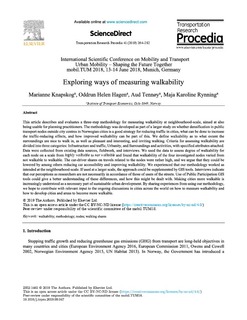| dc.contributor.author | Knapskog, Marianne | |
| dc.contributor.author | Hagen, Oddrun Helen | |
| dc.contributor.author | Tennøy, Aud | |
| dc.contributor.author | Rynning, Maja Karoline | |
| dc.coverage.spatial | Norway | nb_NO |
| dc.date.accessioned | 2019-12-17T12:46:19Z | |
| dc.date.available | 2019-12-17T12:46:19Z | |
| dc.date.created | 2019-12-06T12:48:41Z | |
| dc.date.issued | 2019-11-28 | |
| dc.identifier.citation | Transportation Research Procedia. 2019, 41, 264-282. | nb_NO |
| dc.identifier.issn | 2352-1465 | |
| dc.identifier.uri | http://hdl.handle.net/11250/2633673 | |
| dc.description.abstract | This article describes and evaluates a three-step methodology for measuring walkability at neighbourhood-scale, aimed at also being usable for planning practitioners. The methodology was developed as part of a larger study on whether densification in public transport nodes outside city centres in Norwegian cities is a good strategy for reducing traffic in cities, what can be done to increase the traffic-reducing effects, and how improved walkability can be part of this. We define walkability as to what extent the surroundings are nice to walk in, as well as pleasant and interesting, and inviting walking. Criteria for assessing walkability are divided into three categories: Infrastructure and traffic, Urbanity, and Surroundings and activities, with specified attributes attached. Data were collected from existing data sources, fieldwork, and interviews. We used the data to assess degree of walkability for each node on a scale from highly walkable to not walkable and found that walkability of the four investigated nodes varied from not walkable to walkable. The car-driver shares on travels related to the nodes were rather high, and we argue that they could be lowered by among others reducing car accessibility and improving walkability. We experienced that our methodology worked as intended at the neighbourhood-scale. If used at a larger scale, the approach could be supplemented by GIS tools. Interviews indicate that our perceptions as researchers are not necessarily in accordance of those of users of the streets. Use of Public Participation GIS tools could give a better understanding of these differences, and how this might be dealt with. Making cities more walkable is increasingly understood as a necessary part of sustainable urban development. By sharing experiences from using our methodology, we hope to contribute with relevant input to the ongoing discussions in cities across the world on how to measure walkability and how to develop cities and areas to become more walkable. | nb_NO |
| dc.language.iso | eng | nb_NO |
| dc.publisher | Elsevier | nb_NO |
| dc.rights | Attribution-NonCommercial-NoDerivatives 4.0 Internasjonal | * |
| dc.rights.uri | http://creativecommons.org/licenses/by-nc-nd/4.0/deed.no | * |
| dc.title | Exploring ways of measuring walkability | nb_NO |
| dc.type | Journal article | nb_NO |
| dc.type | Peer reviewed | nb_NO |
| dc.rights.holder | © 2019 The Authors. Published by Elsevier Ltd. | nb_NO |
| dc.description.version | publishedVersion | nb_NO |
| cristin.unitcode | 7482,1,2,0 | |
| cristin.unitname | Byutvikling og bytransport | |
| cristin.ispublished | true | |
| cristin.fulltext | original | |
| cristin.qualitycode | 1 | |
| dc.identifier.doi | 10.1016/j.trpro.2019.09.047 | |
| dc.identifier.cristin | 1757616 | |
| dc.source.journal | Transportation Research Procedia | nb_NO |
| dc.source.volume | 41 | nb_NO |
| dc.source.pagenumber | 264-282 | nb_NO |

